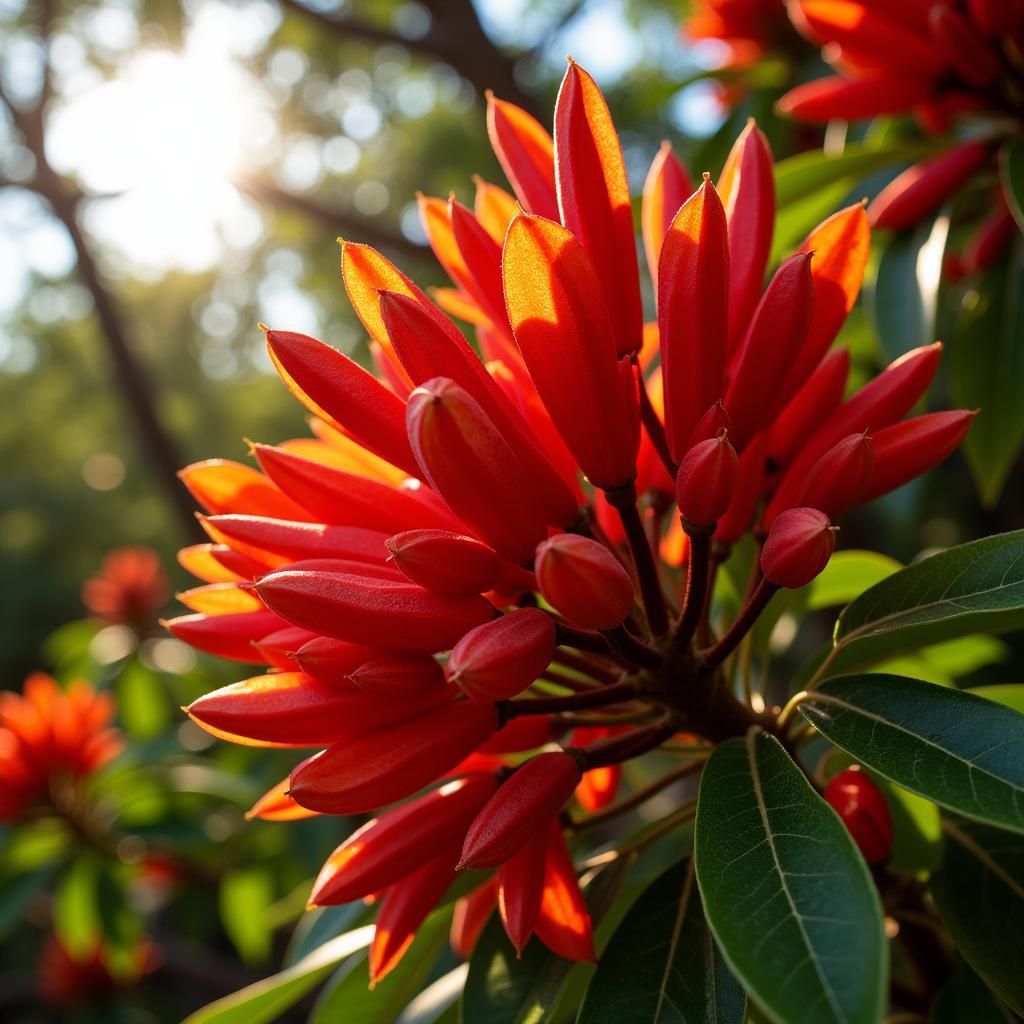Unveiling the Mystery of the African Fire Tree
The African Fire Tree, a vibrant symbol of the African savanna, captivates with its fiery red blooms. This article delves into the fascinating world of this iconic tree, exploring its botanical features, cultural significance, and ecological importance. We’ll uncover the secrets behind its name, its role in local ecosystems, and the captivating stories it holds within its branches. After reading this, you’ll have a deeper appreciation for this stunning emblem of African flora.
What is an African Fire Tree?
The term “African fire tree” can actually refer to several different species, most notably the Brachychiton acerifolius (Illawarra flame tree) and various species within the Spathodea genus. While the Illawarra flame tree isn’t native to Africa, its vibrant display of crimson flowers has led to it being colloquially called a “fire tree” in some parts of the continent where it’s cultivated. The more accurate representation, however, are the Spathodea species, particularly Spathodea campanulata, commonly known as the African tulip tree or fountain tree. It’s this species that we will focus on, exploring its stunning beauty and ecological impact.
This fast-growing tree is adorned with large, cup-shaped, scarlet blossoms that resemble flames dancing amongst the foliage. These striking flowers not only attract pollinators like birds and insects but also provide a rich source of nectar. The Spathodea campanulata thrives in tropical climates and can be found across various regions of Africa, adding a vibrant splash of color to the landscape.
After this initial introduction, you’ll be itching to explore more about this magnificent tree! Now, let’s dive into its unique characteristics and discover why it’s such a beloved symbol of Africa. Explore the 13 African zodiac signs for a deeper understanding of the continent’s rich cultural heritage.
 African Fire Tree in Full Bloom
African Fire Tree in Full Bloom
The Ecology of the African Fire Tree
The African fire tree plays a vital role in its ecosystem. Its vibrant flowers provide a valuable food source for various pollinators, including sunbirds, bees, and butterflies. The seeds are also dispersed by wind and water, aiding in the tree’s propagation. However, it’s important to note that this tree can also be considered invasive in some areas, as its rapid growth can outcompete native species.
Is the African Fire Tree Invasive?
Yes, in some regions outside its native range, the African fire tree can be considered invasive. Its rapid growth and prolific seed production can allow it to quickly colonize new areas, displacing native vegetation and potentially disrupting the balance of the ecosystem. This is a crucial point to consider when cultivating this species. You can learn more about African grasslands to understand the environment these trees can impact.
 African Fire Tree in its Natural Habitat
African Fire Tree in its Natural Habitat
Cultural Significance of the African Fire Tree
Across various African cultures, the African fire tree holds symbolic meaning. Its vibrant blooms are often associated with strength, resilience, and life. In some communities, the wood is used for carving traditional masks and other cultural artifacts. The tree’s presence often marks important gathering places or spiritual sites.
Traditional Uses of the African Fire Tree
Traditional uses of the African fire tree extend beyond its aesthetic appeal. The tree’s bark and leaves have been used in traditional medicine for treating various ailments. Its soft wood is also used for crafting everyday items like canoes and drums. Discovering these uses adds another layer to our understanding of this fascinating tree. If you’re interested in African cuisine, exploring the culinary scene in Johannesburg can be a delightful experience.
“The African fire tree is more than just a beautiful sight; it’s a symbol of life and resilience interwoven with the very fabric of African culture,” says Dr. Abena Oduro, a renowned ethnobotanist specializing in African flora.
The African Fire Tree: A Symbol of Beauty and Resilience
The African fire tree, with its fiery blossoms and rich cultural significance, stands as a testament to the beauty and diversity of the African continent. While its invasiveness in certain regions warrants careful consideration, its ecological role and cultural importance are undeniable. Learning about this tree allows us to appreciate the intricate connections between nature, culture, and history. The African fire tree isn’t just a tree; it’s a story, a symbol, and a vibrant part of the African tapestry.
FAQ
- What are the other names for the African fire tree? It is also known as the African tulip tree or fountain tree.
- Where does the African fire tree grow? It thrives in tropical climates across various regions of Africa.
- Why is it called a “fire tree”? Its vibrant red flowers resemble flames.
- Is the African fire tree always invasive? No, it’s only considered invasive in regions outside its native range.
- What is the cultural significance of the African fire tree? It symbolizes strength, resilience, and life in various African cultures.
- What are some traditional uses of the African fire tree? It’s used in traditional medicine and for crafting various items like canoes and drums.
- What pollinators are attracted to the African fire tree? Sunbirds, bees, and butterflies are common pollinators.
“The tree’s resilience in harsh conditions serves as an inspiration for local communities,” shares Professor Kwame Asante, an expert in African ecosystems. Understanding the biggest tree in Africa can provide further insight into the continent’s diverse flora. You can also find some exciting African Fire Acts that showcase the continent’s rich performing arts.
Need More Information?
- Explore African grassland crossword clue for a fun way to learn more.
For further assistance, please contact us:
Phone: +255768904061
Email: kaka.mag@gmail.com
Address: Mbarali DC Mawindi, Kangaga, Tanzania.
Our customer service team is available 24/7.


